Small spaces don’t mean small possibilities when it comes to garden design. We’ve all faced the challenge of transforming a compact outdoor area into something truly spectacular, and we’re here to show you that size limitations can actually spark the most creative answers.
Whether you’re working with a tiny backyard, a narrow side yard, or even just a small patio space, we’ve discovered that strategic planning and clever design choices can make your garden feel twice as large. The secret lies in maximizing every square inch while creating visual depth and functionality.
We’ll share proven techniques that industry designers use to create stunning small gardens that punch above their weight. From vertical growing answers to space-saving plant selections, these ideas will help you transform your compact outdoor space into a lush retreat that rivals much larger gardens.
Maximize Vertical Space With Climbing Plants and Trellises
Vertical gardening transforms small garden limitations into opportunities for stunning displays. We can effectively triple our growing space by utilizing walls, fences, and vertical structures that draw the eye upward while maximizing every square foot.
Install Wall-Mounted Planters for Herbs and Flowers
Wall-mounted planters create functional growing space without consuming precious ground area. We recommend installing tiered planter systems that hold 3-5 containers per vertical foot, allowing us to grow herbs like basil, oregano, and thyme alongside colorful flowers such as petunias and marigolds.
Strategic placement on south-facing walls provides 6-8 hours of direct sunlight for most plants. Position planters at different heights to create visual interest while ensuring easy access for harvesting and maintenance. Metal brackets with adjustable arms work best for accommodating various container sizes and weights.
Drip irrigation systems can connect multiple wall planters, reducing watering time by 75% compared to hand watering. Choose lightweight containers made from resin or fiber cement to minimize wall stress while maintaining durability through seasonal weather changes.
Create Living Walls With Ivy and Vines
Living walls provide instant privacy while adding lush greenery to vertical surfaces. We suggest fast-growing vines like English ivy, Boston ivy, and Virginia creeper that can cover 20-30 square feet of wall space within two growing seasons.
Installing wire mesh or trellis panels creates support structures for climbing plants to establish strong root systems. Space support wires 12-18 inches apart horizontally to guide vine growth and prevent damage to underlying walls or fences.
Evergreen vines such as winter jasmine and climbing hydrangea maintain year-round coverage in most climate zones. These plants reach mature heights of 15-25 feet, creating substantial visual impact while requiring minimal ground space for root development.
Use Tall Trellises for Privacy and Visual Interest
Tall trellises serve dual purposes as privacy screens and dramatic focal points in small garden spaces. We recommend structures ranging from 6-8 feet in height to create effective barriers while supporting substantial plant growth.
Clematis vines produce spectacular blooms in purple, white, and pink varieties that climb 10-12 feet seasonally. Morning glories and moonflowers offer quick coverage with daily flowering displays that attract beneficial pollinators like bees and butterflies.
Cedar and treated pine trellises withstand weather exposure for 8-12 years without replacement. Position trellises 18-24 inches from property lines to allow adequate growing space while maintaining neighbor relations and property boundaries.
Bamboo screening attached to trellis frameworks provides immediate privacy while plants establish coverage. This combination approach delivers both instant results and long-term beauty as climbing plants mature and fill vertical spaces completely.
Design Multi-Level Garden Beds for Added Dimension
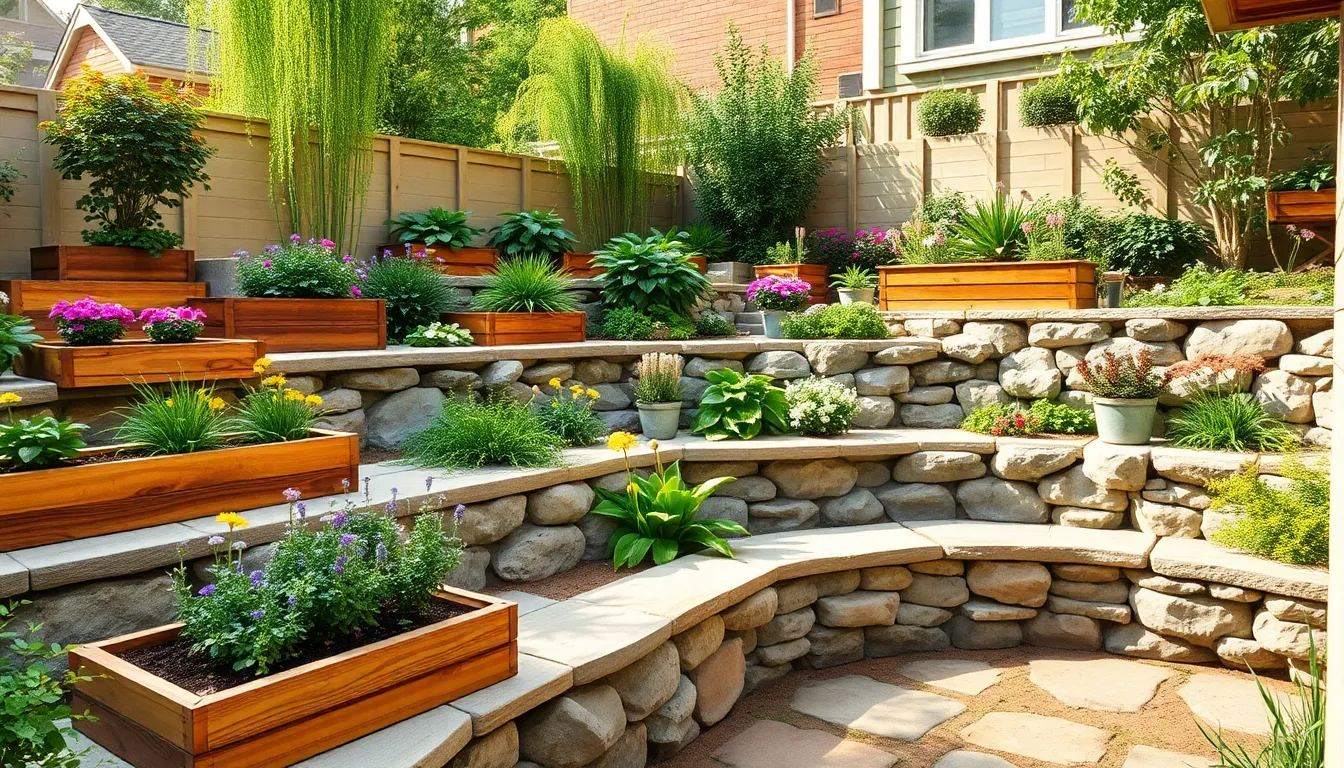
Creating multi-level garden beds helps to add depth and visual interest to a small garden by establishing distinct planting zones at varying elevations.
Build Raised Planter Boxes at Different Heights
Building raised planter boxes at varying heights not only adds dimension but also provides better accessibility for maintenance and planting. We recommend constructing planters at 12, 18, and 24-inch heights to create a cascading effect that draws the eye through different garden levels. Staggered placement of these boxes allows us to maximize planting space while creating natural pathways between each elevated section.
Cedar and composite materials work best for raised planters since they resist moisture damage and maintain their appearance over time. We’ve found that positioning taller boxes toward the back of garden spaces creates depth perception that makes small areas appear larger. Strategic spacing between boxes allows for easy maintenance access while creating micro-climates that support different plant varieties at each level.
Incorporate Tiered Seating With Built-In Planters
Integrating tiered seating with built-in planters can optimize space while providing areas for relaxation and enjoyment of the garden. We design these dual-purpose structures by building stepped concrete or stone benches with integrated planting compartments along the sides and backs. This approach eliminates the need for separate seating and planting areas in space-constrained gardens.
Stone and concrete materials provide durability for seating surfaces while creating defined planting pockets that retain soil effectively. We position these tiered elements against walls or property boundaries to maximize their functionality without encroaching on central garden space. Cushions and weather-resistant pillows can transform these structures into comfortable outdoor living areas while maintaining their practical garden function.
Add Stepped Stone Retaining Walls
Stepped stone retaining walls can help to manage sloping terrain and add a natural, rustic touch to the garden by creating multiple planting terraces. We construct these walls using natural fieldstone or manufactured blocks that step back at each level to create stable planting platforms. Each terrace level provides distinct growing conditions that support different plant selections based on drainage and sun exposure.
Natural stone materials like limestone and sandstone blend seamlessly with garden environments while providing excellent drainage for plant roots. We install these walls with proper drainage systems including gravel backfill and weep holes to prevent water buildup behind each level. The stepped design allows us to plant groundcovers, perennials, and small shrubs at different elevations that create visual flow throughout the garden space.
Choose Compact Plants That Pack Maximum Visual Impact
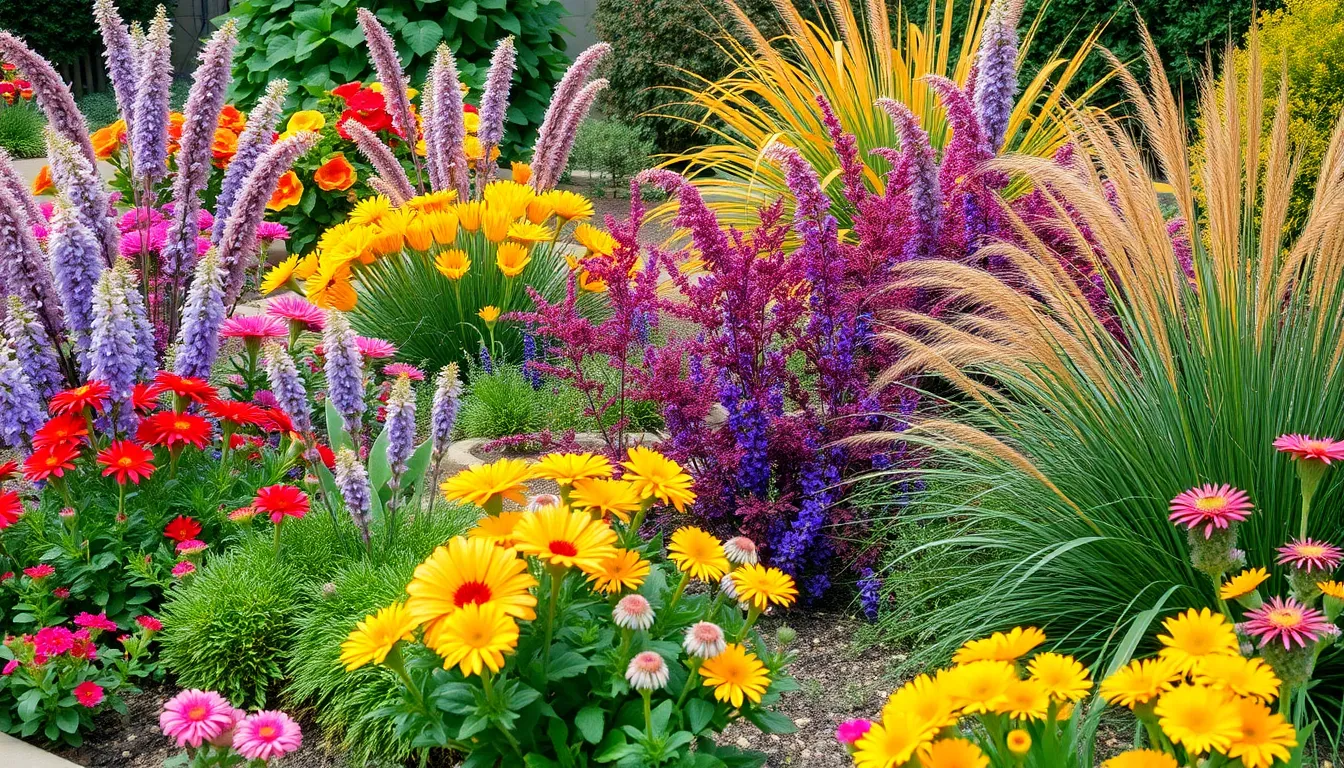
Selecting the right plants transforms small gardens into vibrant showcases without overwhelming limited space. We’ll focus on species that deliver stunning visual results while maintaining proper proportions for compact areas.
Select Dwarf Varieties of Popular Shrubs and Trees
Dwarf varieties offer all the beauty of their full-sized counterparts while fitting perfectly into small garden spaces. Compact boxwood creates elegant hedging that stays naturally neat with minimal pruning requirements. Dwarf fruit trees like compact apple or cherry varieties provide seasonal blooms, fruit production, and attractive foliage without dominating your garden layout.
These specially bred plants maintain their smaller stature throughout their lifespan, eliminating concerns about outgrowing your space. Japanese maples in dwarf forms add stunning fall color, while miniature roses deliver continuous blooms in containers or border plantings. We recommend choosing varieties that serve multiple purposes, such as dwarf conifers that provide year-round structure and winter interest.
Plant Colorful Annual Flowers in Succession
Succession planting ensures your small garden maintains vibrant color throughout the entire growing season. Colorful annuals like marigolds, zinnias, and petunias can be planted every 2-3 weeks to create continuous flowering displays. This technique prevents gaps in color when earlier plantings fade or finish their blooming cycle.
Start with cool-season annuals like pansies and snapdragons in early spring, then transition to heat-loving varieties such as impatiens and begonias for summer displays. Container gardening makes succession planting easier, allowing you to swap out tired plants for fresh specimens without disturbing established plantings. We suggest keeping backup seedlings in small pots ready for quick replacements when needed.
Incorporate Ornamental Grasses for Texture
Ornamental grasses add movement, texture, and architectural interest that enhances small garden designs significantly. Fountain grass creates soft, flowing lines that contrast beautifully with rigid hardscaping elements like paths or walls. Compact varieties like blue fescue or Japanese forest grass work perfectly in small spaces while providing four-season appeal.
These versatile plants require minimal maintenance once established and offer drought tolerance that reduces watering needs. Feather reed grass grows upright, making it ideal for narrow spaces or as living screens between garden areas. We find that mixing different grass textures creates visual depth, with fine-textured grasses like hair grass complementing broader-leafed varieties such as sedges or hostas.
Create Illusions of Space With Strategic Design Elements
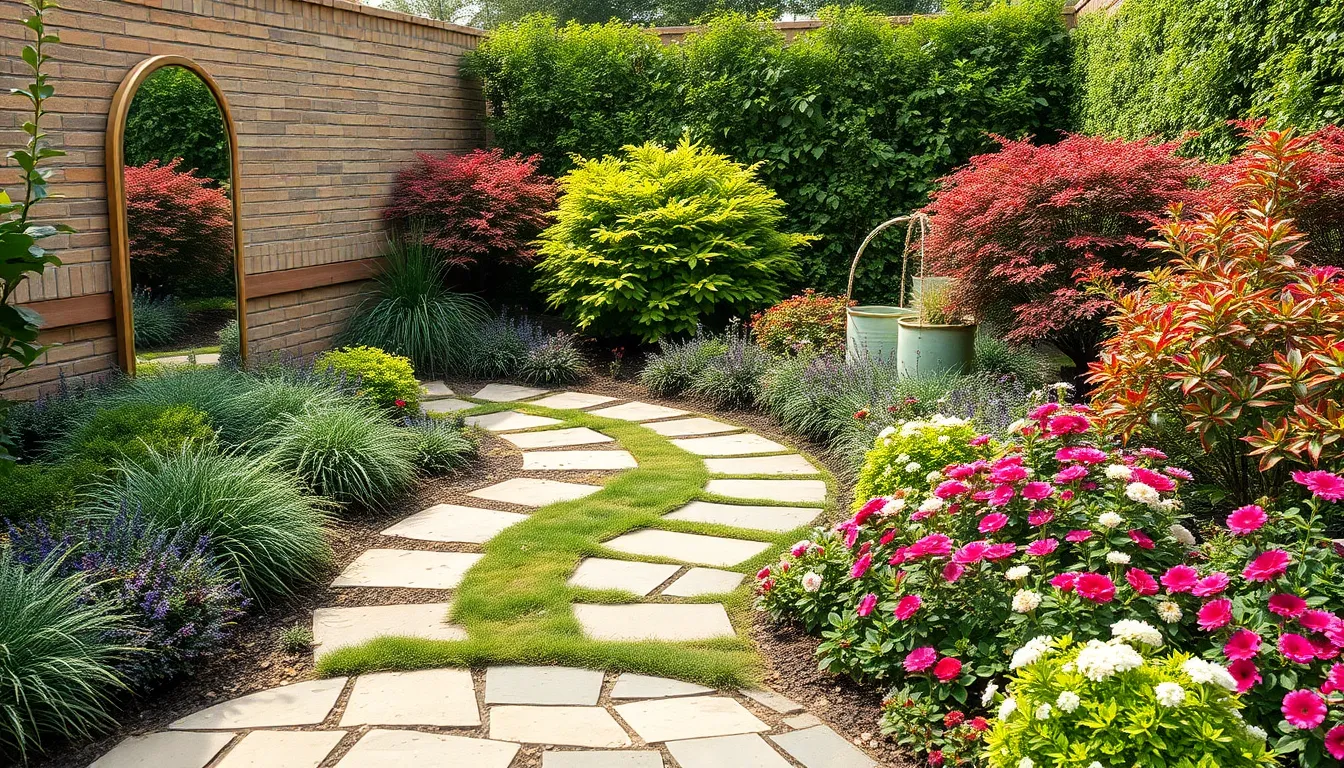
Smart optical tricks can transform your compact garden into what feels like a much larger outdoor sanctuary. We’ll show you three proven techniques that professional designers use to make small spaces appear more expansive and inviting.
Use Mirrors to Reflect Light and Expand Views
Mirrors work like magic in small garden spaces by bouncing light around and creating the perception of doubled garden area. Strategically placing weather-resistant mirrors against walls or fences reflects your existing plantings and makes visitors feel like they’re looking into another garden room. We recommend positioning mirrors to catch morning or evening light for maximum brightness enhancement.
Reflective surfaces don’t stop at traditional mirrors—polished metal panels, mirrored tiles, and even water features create similar space-expanding effects. Garden mirrors should be angled slightly downward to reflect your best plantings rather than the sky. You’ll want to choose mirrors with beveled edges or decorative frames that complement your garden style while creating those important sight lines that trick the eye.
Install Curved Pathways Instead of Straight Lines
Curved walkways create mystery and visual depth that straight paths simply can’t match in compact spaces. When we can’t see where a path leads, our minds assume the garden continues beyond what’s visible, making the space feel larger than its actual dimensions. Gentle S-curves work particularly well because they slow down foot traffic and encourage people to notice more plantings along the way.
Curved designs also allow you to fit more pathway into your available space without overwhelming the garden with hardscaping. We suggest using materials like flagstone, brick, or decorative gravel that can easily follow organic curves. The key is making your curves feel natural rather than forced—follow the natural contours of your space or create gentle arcs that lead the eye toward focal points like specimen plants or garden art.
Place Larger Plants in Back and Smaller Ones in Front
Layered planting creates a sense of depth that makes viewers feel like they’re looking into a much larger industry. By positioning taller shrubs, small trees, and large perennials toward the back of your garden beds, you establish a backdrop that frames smaller plants in front. This arrangement mimics how we naturally perceive depth in larger natural settings.
The contrast between plant sizes enhances this depth effect—pair dwarf hostas with tall ornamental grasses, or place compact annuals in front of medium-sized shrubs. We recommend thinking of your garden as a theater stage where each plant has a exact role based on its height and visual weight. This layering technique works especially well when you use light-colored or variegated plants in front, as they’ll appear to come forward while darker foliage recedes into the background.
Incorporate Multi-Functional Features for Practical Beauty

Smart features that serve multiple purposes transform small gardens into efficient outdoor spaces. We can maximize every square foot by choosing elements that combine beauty with functionality.
Add Storage Benches That Double as Seating
Storage benches eliminate the need for separate seating and storage answers in compact gardens. We recommend weatherproof cedar or teak benches with lift-up seats that protect gardening tools from moisture and theft. These versatile pieces provide comfortable spots to rest while keeping essential items like pruning shears, gloves, and small hand tools within easy reach.
Position storage benches along pathways or near garden beds where you’ll need tools most frequently. Built-in cushions make these benches perfect for morning coffee breaks or evening garden observation. Waterproof interior compartments keep fertilizers and seeds dry during rainy seasons while maintaining a clean garden aesthetic.
Install Fountain Features That Save Space
Compact fountains serve as both decorative focal points and practical irrigation systems in small gardens. Solar-powered fountain units reduce electricity costs while providing the soothing sound of flowing water that masks urban noise. We suggest wall-mounted or corner fountains that don’t consume valuable ground space.
These water features create microclimates that benefit nearby plants through increased humidity levels. Recirculating systems conserve water while maintaining consistent moisture for container plants placed around the fountain base. Tiered fountain designs maximize water flow surface area without requiring large footprints.
Create Edible Landscapes With Vegetable Gardens
Edible landscaping combines productivity with visual appeal through strategic plant placement and design. We design potager-style gardens that integrate vegetables, fruits, and flowers in geometrically arranged beds for maximum beauty and harvest potential. These kitchen gardens work especially well in sunny locations where food plants can thrive.
Colorful vegetables like purple cabbage, rainbow chard, and cherry tomatoes provide ornamental value alongside their culinary benefits. Herb borders create fragrant pathways while supplying fresh seasonings for cooking. Dwarf fruit trees serve as living sculptures that produce seasonal harvests without overwhelming small spaces through their compact growth habits.
Use Container Gardening for Flexibility and Mobility
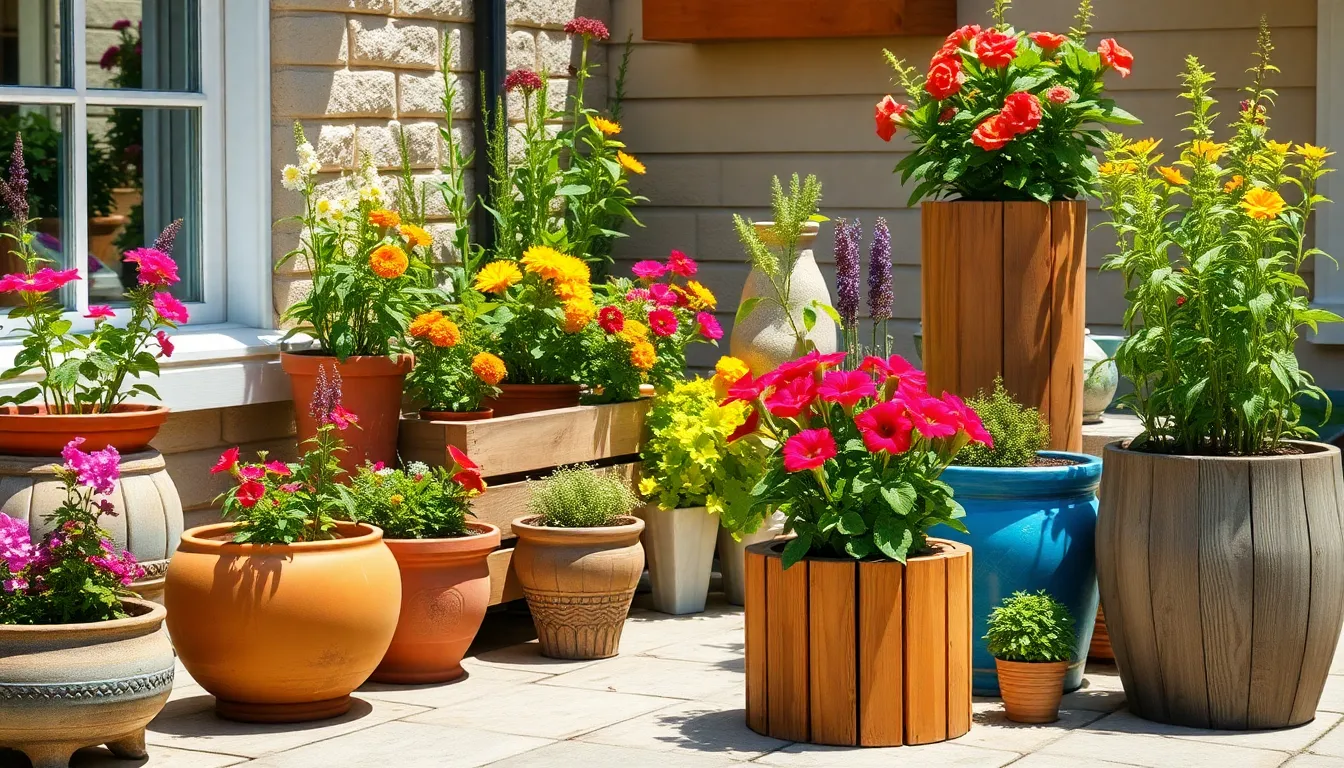
Container gardening transforms small outdoor spaces by offering unmatched adaptability and movement options. We can easily relocate plants throughout the season to optimize sunlight exposure and create fresh garden arrangements.
Group Pots of Varying Sizes for Visual Appeal
Grouping containers of different dimensions creates stunning visual displays that add depth to compact spaces. We recommend combining small herb planters with medium flower pots and large vegetable containers to establish natural height variations. This layered approach mimics traditional garden beds while maintaining the flexibility that container gardening provides.
Different container shapes enhance the overall aesthetic appeal of your arrangement. Round ceramic pots paired with rectangular wooden planters and tall cylindrical vessels create ever-changing visual interest. We suggest using three to five containers per grouping to avoid overwhelming the space while maximizing impact.
Color coordination between containers amplifies the professional appearance of your garden display. Neutral tones like terracotta, white, and natural wood allow plant colors to take center stage, while bold container colors can serve as striking accent pieces throughout your small garden design.
Choose Lightweight Containers for Easy Rearrangement
Lightweight materials help frequent repositioning without physical strain or damage to delicate plant roots. Fiberglass and resin containers offer durability while remaining easy to lift and move as your garden layout evolves. These materials resist weather damage better than traditional clay pots while weighing significantly less.
Mobility becomes essential when optimizing sunlight exposure throughout different seasons. We can move shade loving plants to protected areas during intense summer heat, then relocate them to brighter spots during cooler months. This flexibility allows us to accommodate each plant’s changing needs without permanent installation constraints.
Drainage considerations remain important when selecting lightweight containers for your mobile garden setup. Containers with built in drainage holes prevent waterlogging while maintaining the portability advantages that make container gardening so effective in small spaces.
Select Self-Watering Systems for Low Maintenance
Self-watering containers reduce daily maintenance requirements by maintaining consistent soil moisture levels automatically. These systems include built in water reservoirs that gradually release moisture to plant roots, eliminating the guesswork from watering schedules. We find this particularly beneficial for busy gardeners or those new to container cultivation.
Moisture retention technology in these containers prevents both overwatering and underwatering situations that commonly affect traditional pots. The reservoir system allows plants to absorb water as needed, creating optimal growing conditions while reducing our time investment in daily garden care.
Setup simplicity makes self-watering containers ideal for small garden beginners who want professional results without extensive experience. Most systems require only initial water reservoir filling and periodic refills, making them perfect for weekend gardeners or those with demanding schedules who still want thriving container gardens.
Implement Smart Lighting Solutions for Evening Ambiance
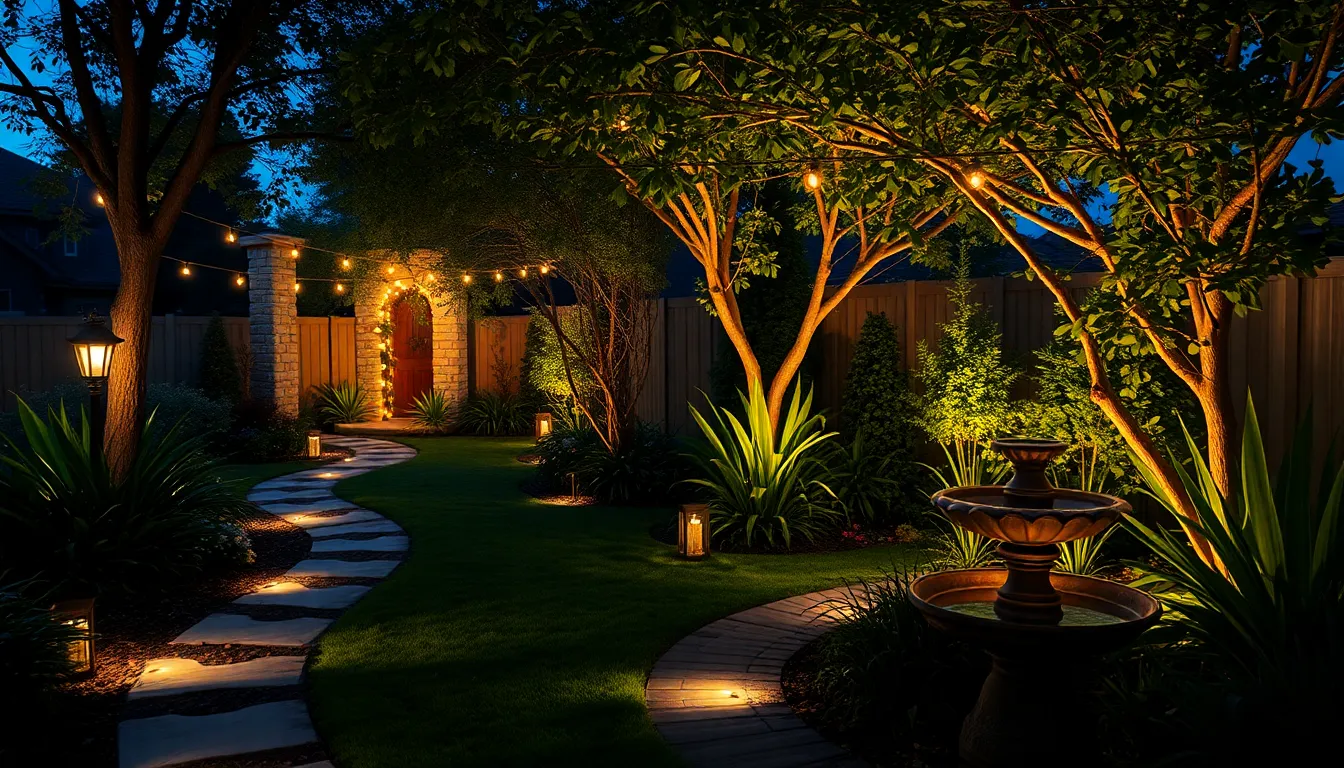
Strategic lighting transforms our small gardens into enchanting evening retreats that extend usable hours well into the night. We’ll explore three essential lighting approaches that maximize visual impact while minimizing installation complexity and energy costs.
Install Solar-Powered Pathway Lights
Solar powered pathway lights offer the most practical solution for illuminating garden walkways without increasing electricity bills. We position these lights every 6 to 8 feet along curved pathways to create gentle guidance while highlighting the natural flow of our garden design. Modern solar fixtures store enough energy during daylight hours to provide 8 to 12 hours of continuous illumination throughout the night.
Installation becomes remarkably simple since we don’t need electrical wiring or professional help. We select fixtures with adjustable brightness settings to customize the ambiance level based on seasonal preferences. Stainless steel and weather resistant materials ensure our pathway lights withstand harsh weather conditions for multiple years.
We place solar lights strategically near plantings to showcase foliage textures and create subtle shadows that add depth to our compact spaces. The warm LED glow from quality solar fixtures enhances the colors of evening blooming flowers like moonflowers and four o’clocks.
Add String Lights for Cozy Atmosphere
String lights create the most versatile and cost effective way to add magical ambiance to our small garden spaces. We hang Edison bulb strings between trees, pergolas, or fence posts to establish intimate outdoor living areas perfect for evening relaxation. Commercial grade outdoor string lights provide consistent illumination and resist weather damage better than standard indoor varieties.
Creative installation patterns make our gardens feel larger and more inviting after dark. We drape lights in zigzag patterns across seating areas or create canopy effects by connecting multiple strings at varying heights. Battery powered LED string lights offer complete flexibility for areas without electrical access.
We choose warm white or soft yellow bulbs that complement our garden’s natural colors rather than harsh blue tones that create cold atmospheres. Timer controls allow us to automatically activate string lights at sunset and turn them off during late night hours to conserve energy.
Use Uplighting to Highlight Key Features
Uplighting creates dramatic focal points that draw attention to our garden’s most beautiful elements during evening hours. We install small LED spotlights at ground level to illuminate specimen trees, sculptural plants, or decorative garden structures from below. This technique makes our compact spaces feel more spacious by creating vertical visual interest that draws the eye upward.
We position uplights 3 to 4 feet away from target plants to achieve optimal coverage without creating harsh shadows. Adjustable beam angles let us customize the light spread based on plant size and desired effect. Low voltage LED uplights consume minimal electricity while producing brilliant illumination that lasts for years.
Water features benefit tremendously from strategic uplighting that creates shimmering reflections and highlights moving water. We use submersible LED lights in small fountains or ponds to create stunning nighttime displays that serve as natural focal points in our garden design.
Conclusion
Small gardens don’t have to mean small dreams. With the right combination of vertical growing answers multi-level design elements and space-maximizing techniques we’ve outlined you can create an outdoor sanctuary that rivals any large industry.
The key lies in embracing creative constraints and viewing limitations as opportunities for innovation. From living walls to compact plant selections every square foot becomes valuable real estate for beauty and function.
Your small garden transformation starts with choosing just one or two techniques that resonate with your vision. Whether it’s installing a trellis system grouping containers strategically or adding ambient lighting the impact will be immediately noticeable.
Remember that successful small garden design isn’t about cramming in as many elements as possible—it’s about thoughtful selection and purposeful placement that creates maximum visual and functional impact.
Frequently Asked Questions
What are the best plants for small outdoor spaces?
Choose compact varieties that maximize impact without overwhelming the space. Dwarf shrubs, compact boxwood, dwarf fruit trees, and ornamental grasses work exceptionally well. Consider succession planting with colorful annuals for continuous blooms throughout the season. These plants maintain smaller statures while providing seasonal beauty and texture.
How can I make my small garden look bigger?
Use strategic design illusions like mirrors to reflect light and expand views. Create curved pathways instead of straight lines to add mystery and visual depth. Implement layered planting with larger plants at the back and smaller ones in front to create natural depth and enhance visual appeal.
What are the benefits of vertical gardening in small spaces?
Vertical gardening can triple your growing space by utilizing walls and vertical structures. Use climbing plants, trellises, and wall-mounted planters to grow herbs and flowers without taking up ground space. This approach maximizes functionality while creating privacy screens and lush greenery in compact areas.
How do I create multiple levels in a small garden?
Design multi-level garden beds using raised planter boxes at varying heights for better accessibility and visual interest. Consider tiered seating with built-in planters and stepped stone retaining walls for sloping terrain. These create distinct planting terraces with different growing conditions while adding depth.
What multi-functional features work best in compact gardens?
Incorporate storage benches that double as seating, compact fountain features for decoration and irrigation, and edible landscapes combining vegetables, fruits, and flowers. These solutions maximize space efficiency while providing both practical benefits and aesthetic appeal for year-round enjoyment.
How can I improve lighting in my small outdoor space?
Implement three key lighting approaches: solar-powered pathway lights for walkways, string lights for cozy atmosphere, and uplighting to highlight key features. These smart lighting solutions extend evening usability, enhance visual appeal, and create dramatic focal points without increasing electricity costs.
Is container gardening suitable for small spaces?
Yes, container gardening offers excellent flexibility and mobility for small areas. Group pots of varying sizes for visual appeal and use lightweight materials for easy rearrangement. Consider self-watering systems for low maintenance, ensuring consistent soil moisture while reducing time investment for busy gardeners.







